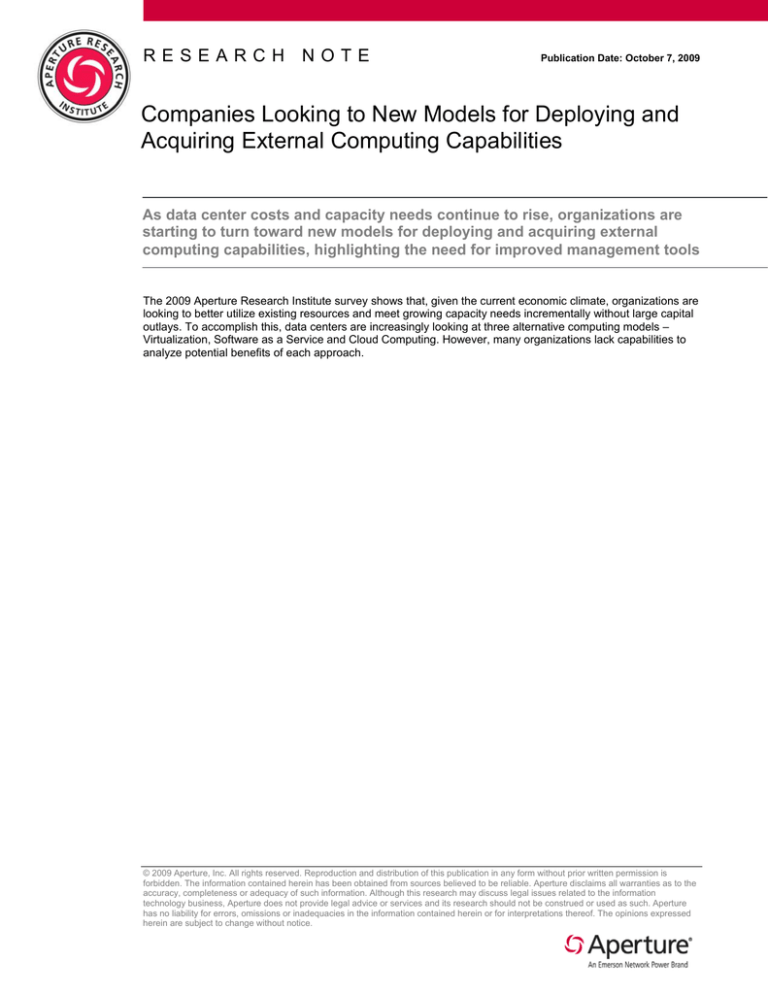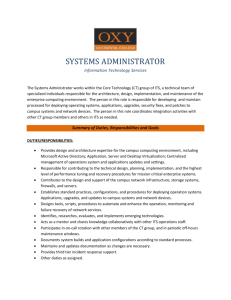Companies Looking to New Models for Deploying and
advertisement

RESEARCH NOTE Publication Date: October 7, 2009 Companies Looking to New Models for Deploying and Acquiring External Computing Capabilities As data center costs and capacity needs continue to rise, organizations are starting to turn toward new models for deploying and acquiring external computing capabilities, highlighting the need for improved management tools The 2009 Aperture Research Institute survey shows that, given the current economic climate, organizations are looking to better utilize existing resources and meet growing capacity needs incrementally without large capital outlays. To accomplish this, data centers are increasingly looking at three alternative computing models – Virtualization, Software as a Service and Cloud Computing. However, many organizations lack capabilities to analyze potential benefits of each approach. © 2009 Aperture, Inc. All rights reserved. Reproduction and distribution of this publication in any form without prior written permission is forbidden. The information contained herein has been obtained from sources believed to be reliable. Aperture disclaims all warranties as to the accuracy, completeness or adequacy of such information. Although this research may discuss legal issues related to the information technology business, Aperture does not provide legal advice or services and its research should not be construed or used as such. Aperture has no liability for errors, omissions or inadequacies in the information contained herein or for interpretations thereof. The opinions expressed herein are subject to change without notice. COMPANIES LOOKING TO NEW MODELS FOR DEPLOYING AND ACQUIR9NG EXTERNAL COMPUTING CAPABILITIES Introduction As data center costs continue to rise and capacity needs continue to increase, companies are turning toward new models for acquiring external computing capabilities. Many organizations are looking to improve the utilization of existing resources through virtualization and meet capacity needs incrementally without investing in large capital outlays by turning to new models for acquiring external computing capabilities that will allow them to cut costs and improve performance while reacting faster to requests for additional computing. While three alternative computing models – Virtualization, Software as a Service (SaaS) and Cloud Computing – are currently receiving a lot of attention in the industry, the 2009 Aperture Research Institute (ARI) survey results show that there is still significant room for growth in the utilization of these three models. Virtualization is the most mature of the models, with nearly all data centers having adopted the technology. Only six percent of the business leaders surveyed said they have no virtualization in their data center. A smaller amount of respondents utilize SaaS. Fifty-nine percent currently have anywhere between 1-15 percent of their software deployed as SaaS. The survey also shows that the one model receiving the most attention, Cloud Computing, is also the least adopted of the three, with 73 percent of respondents saying they do not currently house any applications in the cloud. As companies evaluate these three models, it is important that they have a clear understanding of the current state of their data center operations. Only by understanding their infrastructure utilization, resource usage and capacity needs will IT and data center managers be able to choose the option that is best suited to help them acquire additional compute capacity. And the issue of additional capacity is expected to continue to be a major concern for data centers. A recent Gartner survey released in July 2009 reported that approximately 63 percent of respondents said they will face data center capacity constraints in the next 18 months. More importantly, 15 percent said their data centers are 1 at capacity; they will be forced to build a new site or refurbish their existing sites within the next 12 months. The results of this research note are based on a detailed survey of more than 100 data center professionals across a range of sectors including the healthcare, banking and insurance, retail, telecommunications, government and pharmaceutical industries. 1 “Data Centers Focus on Green IT, but Many Neglect Metrics,” Rakesh Kumar, Gartner, July 2009 ©2009 Aperture Technologies, Inc COMPANIES LOOKING TO NEW MODELS FOR DEPLOYING AND ACQUIR9NG EXTERNAL COMPUTING CAPABILITIES Virtualization is the Most Adopted and Understood Alternative Computing Model PC Magazine defines virtualization “as running applications in separate, isolated partitions (separate "virtual machines") within a single server. Each virtual machine runs its own OS and application and can be moved or copied from one server to another for load balancing, to expand processing capability and to recover from 2 hardware failure.” According to the ARI’s latest study of over 100 data center managers, virtualization is most adopted of the three models, with almost all of the data centers covered in the survey implementing the technology. Only six percent of respondents said their data center had no virtualization. Forty-nine percent responded that up to 15 percent of their data center was virtualized, while 31 percent said that up to 30 percent was virtualized. These results are consistent with those published by Gartner in its July 2009 green IT survey. The research firm concluded that virtualization is the main mechanism through which data center and IT managers are lowering their data center energy costs. Seventy-one percent of Gartner survey respondents said they are using virtualization as their main mechanism to manage energy costs.3 The ARI predicts that much of this adoption can be attributed to the fact that there seems to be a clear understanding of the benefits the technology provides to data centers, primarily in the areas of server utilization, reliability and agility. Those 94 percent who are utilizing virtualization reported that it has had an impact on their ability to manage their data center infrastructure. Sixty-seven percent reported that virtualization has enhanced data center space utilization; 47 percent said that it reduced demand for power; 40 percent said that it reduced demand for cooling; and 39 percent reported that it has increased infrastructure performance. How has virtualization impacted your ability to manage the data center infrastructure? 80% 67% 60% 47% 40% 40% 39% 20% 14% 13% 6% 0% Increased infrastructure performance 2 3 Increased visibility into data center infrastructure Enhanced data center space utilization Reduced demand Reduced demand for power for cooling None of the above PCMag.com Encyclopedia, http://www.pcmag.com/encyclopedia/ “Data Centers Focus on Green IT, but Many Neglect Metrics,” Rakesh Kumar, Gartner, July 2009 ©2009 Aperture Technologies, Inc We are not using virtualization COMPANIES LOOKING TO NEW MODELS FOR DEPLOYING AND ACQUIR9NG EXTERNAL COMPUTING CAPABILITIES Software as a Service (SaaS) is gaining ground Software as a Service (SaaS) is a software distribution model in which software applications are rented rather than purchased. Instead of buying software and paying for periodic upgrades, SaaS is subscription based, and 2 all upgrades are provided during the term of the subscription. While the ARI survey results shows that a smaller amount of respondents are currently utilizing SaaS, they also point to an expected increase in that number driven by a number of factors. Fifty-nine percent of those surveyed stated that up to 15 percent of their software is currently deployed as SaaS; 10 percent stated they have up to 30 percent deployed as SaaS; and 28 percent reported that they currently do not have any software deployed as SaaS. Given the continuing need for more capacity, that number is expected to increase. Of those surveyed, 42 percent of respondents expect to see an increase in their use of SaaS during the next two years. Five percent even anticipate their usage to significantly increase during that time period. What change do you expect to see in your use of SaaS over the next two years? 60% 51% 42% 40% 20% 5% 2% 0% 0% Increase a lot Increase somewhat Remain flat Decrease somewhat Decrease a lot Those respondents who expect their use of SaaS to increase point to a variety of factors driving that increase. Forty-three percent cited a reduced cost of deploying new software; 18 percent cited a desire to manage software from a central location, and 16 percent both cited a reduced cost of mainlining software and reduced cost of data center infrastructure needed to support applications. ©2009 Aperture Technologies, Inc COMPANIES LOOKING TO NEW MODELS FOR DEPLOYING AND ACQUIR9NG EXTERNAL COMPUTING CAPABILITIES If your use of SaaS is expected to increase somewhat or a lot, what is the primary driver behind this increase? 60% 43% 40% 18% 20% 16% 16% Reduced cost of maintaining software Reduced cost of data center infrastructure needed to support applications 7% 0% Need to access software globally Desire to manage Reduced cost of software from a central deploying new software location Cloud Computing Shows Modest Potential for Growth Cloud computing is the use of applications and services that are hosted externally and provided over the Internet. It has been popularized by Web applications like Salesforce, Google Docs and Web-based e-mail. While cloud computing is the least adopted of the three models, this year’s ARI survey does show modest potential for growth, with 45 percent expecting to increase their use of the technology during the next two years. The 45 percent increase in adoption rate partly reflects how new this technology is, with 73 percent saying that they currently do not have any applications hosted in the cloud, and the rest saying that no more than 15 percent of their applications are hosted via cloud computing. What change do you expect to see in your use of cloud computing over the next two years? 60% 52% 41% 40% 20% 4% 3% 1% 0% Increase a lot ©2009 Aperture Technologies, Inc Increase somewhat Remain flat Decrease somewhat Decrease a lot COMPANIES LOOKING TO NEW MODELS FOR DEPLOYING AND ACQUIR9NG EXTERNAL COMPUTING CAPABILITIES Further ARI survey findings point to the reasons for the rising interest in cloud computing. Thirty-eight percent of respondents stated that they believe that cloud computing is a less expensive alternative to adding new infrastructure, while 17 percent said it is less expensive than utilizing their existing infrastructure. The need for additional capacity, cited by 17 percent, and the need for improved performance, named by 17 percent, are key drivers for the adoption of cloud computing. This reflects a climate where limited budgets make it difficult to meet the business’ expectations for its services by procuring IT for internal hosting. If your usage of cloud computing is expected to increase somewhat or a lot, what is the primary driver behind this increase? 38% 40% 30% 20% 17% 17% 17% 11% 10% 0% Need for additional capacity ©2009 Aperture Technologies, Inc Need for greater performance Need to access information globally Reduced cost compared Reduced cost compared to deploying existing to deploying new infrastructure infrastructure COMPANIES LOOKING TO NEW MODELS FOR DEPLOYING AND ACQUIR9NG EXTERNAL COMPUTING CAPABILITIES Survey Methodology More than 100 data center professionals and executives from a variety of industries participated in this online survey. Survey participants were solicited from an industry database of Aperture customers and prospects. The charts below illustrate the demographics of companies that took part in the survey. Annual revenue of participating organizations Less than $100M 19% $100M - $250M $250M - $500M $500M - $1B 46% Over $1B 12% 5% 18% The chart below shows the cross section of types of businesses that participated in the survey. It includes companies across various vertical industries and ranges from smaller businesses to Fortune 100 companies. Primary industry of participating organizations 9% 0% 1%2% 2% 2%2% 2% 2% 2% 2% 13% 3% 3% 4% 4% 12% 5% 6% 10% 7% 8% ©2009 Aperture Technologies, Inc Chemicals Semiconductors Computer Software Diversified Financials Energy Securities Radio- and TV-Broadcasting Engineering Computer Equipment Pharmaceuticals Airline Insurance Manufacturing Utilities Transport and Logistics Telecoms Retail Health care Education Government Computer/Data Services Banks Other COMPANIES LOOKING TO NEW MODELS FOR DEPLOYING AND ACQUIR9NG EXTERNAL COMPUTING CAPABILITIES Conclusions The results of the 2009 Aperture Research Institute survey further confirm what many in the industry already understand. Cloud computing, software as a service (SaaS) and virtualization are presenting data center and IT managers with a new paradigm for managing their IT operations that better utilizes computing resources, reduces capital expenditures and improves reliability of IT services. At a time when budgets are tight and demand is rising, the return on investment for one of these models could be proportional to the amount of capacity it can make available. However, without accurate information on the status of a data center’s equipment and physical resources, as well as its capacity needs, it is impossible to clearly understand which model may provide the best solution and build an implementation plan for rolling it out. IT and data center managers need to have a comprehensive cost model for the services they offer. Many will also need to invest in data center management systems to ensure they have sufficient insight into cost and availability of physical resources in order to manage them more efficiently and effectively. These systems will also help manage these increasingly complex environments to help IT and data center managers fully realize the promises of these new models. While 45 percent of respondents did say they expected an increase in cloud computing use in the next two years, 52 percent did not expect to see any change. One reason for this might be that many organizations cannot measure the benefit to their organization for adopting cloud computing. The information gained through the use of a data center management system will help in evaluating the different options for acquiring additional compute capacity (including the traditional model) and identifying the specific benefits and costs of each model. The absence of this type of information may very well be one of the factors dragging down cloud computing adoption. The Aperture Research Institute is dedicated to providing the market with current information and trends on enterprise data centers. The ARI plans to publish new research notes on a quarterly basis. To read the latest research findings, visit www.apertureesearchinstitute.org. CORPORATE HEADQUARTERS EUROPEAN HEADQUARTERS Aperture Technologies 9 Riverbend Drive South Stamford, CT 06907 Aperture Technologies 288 Bishopsgate London EC2M 4QP United Kingdom tel 203.357.0800 800.346.6828 fax 203.357.0809 ©2009 Aperture Technologies, Inc www.aperture.com tel +44 (0)20 7959 3024 fax +44 (0)20 7959 3030 © 2009. All rights reserved. Aperture and Aperture VISTA are registered trademarks and the Aperture logo mark is a trademark of Aperture Technologies, Inc. All other trademarks are the property of their respective owners.






